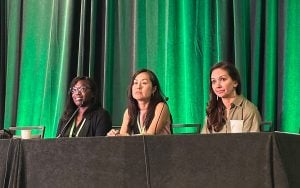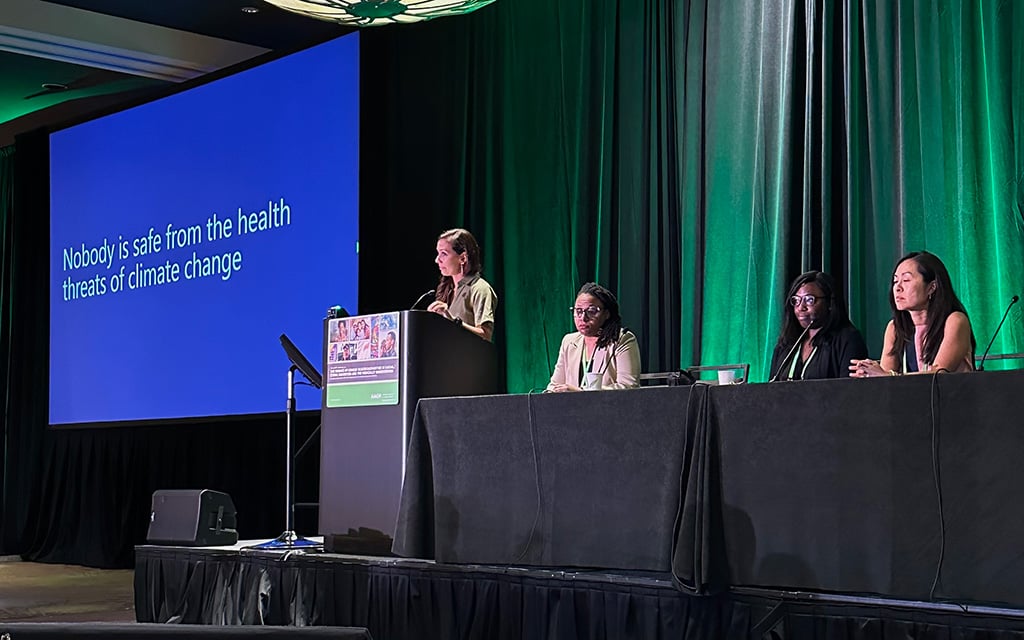LOS ANGELES – Last month, experts examined cancer in medically underserved communities at the 17th annual American Association for Cancer Research Conference in Los Angeles. One panel was dedicated to the intersections of climate change and cancer disparities.
The panelists said there is a need for a more equitable approach to environmental justice and cancer care among marginalized communities.
Dr. Christine Ekenga, an assistant professor at Emory University’s Rollins School of Public Health, says that the harmful health impacts of a rapidly changing climate is a chance to come together to better the well-being of those who struggle the most.
“Climate change is often considered the greatest global public health threat in the 21st century … but it also may be the greatest global health opportunity,” Ekenga said. “Addressing climate impacts is an enormous opportunity to enhance health equity … while also dealing with climate risk one way or another.”
According to the National Oceanic and Atmospheric Administration, the U.S. just endured its fourth-hottest summer. Ekenga emphasized how climate adversities in the Southwest disproportionately affect historically marginalized communities.

Panel speakers from left: Dr. Christine Ekenga, Dr. Iona C. Cheng and Dr. Leticia M. Nogueira. Photo taken on September 24, 2024. (Photo by Brandelyn Clark/Cronkite News)
“Because of issues related to environmental justice … income and residential segregation, these communities are some of the most vulnerable,” said Ekenga. “It exacerbates their risk, and then afterward … it can influence their ability to seek the proper treatment … it has an impact across the continuum from risk through survivorship.”
Extreme heat has plagued the Southwest, with multiple states shattering temperature records. Arizona experienced 113 consecutive days of temperatures at or above 100 degrees, surpassing a record set in 1993. Cities in Nevada and California also reached all-time highs, maxing out at Death Valley National Park, which registered 129 degrees in July.
Residents of these states are at risk from heat-related injury and illnesses, but for unhoused individuals and historically underserved communities, finding protection from the heat could be the difference between life and death.
Another panelist at the conference, Dr. Leticia M. Nogueira of the American Cancer Society, discussed how racial discrimination and structural inequalities limit access to resources, making specific neighborhoods more vulnerable to long-term health disparities.
“Our society is structured in hierarchical layers, meaning some people are considered more worthy of protection and investment than others. One of the most widely recognized examples is redlining,” Nogueira said.
Redlining is the discriminatory practice of labeling neighborhoods “high-risk” investments based solely on race. Although outlawed since 1968, redlining widened the wealth gap between white and non-white communities, creating challenges for residents of the latter to receive loans and mortgages for generations.
The growing intensity of heat and more frequent heat waves have worsened the situation.
According to Berkeley Public Health, people in formerly redlined areas experience higher rates of chronic illnesses like heart disease, asthma, and cancer. One factor is that these communities are twice as likely to have oil and gas wells nearby. This proximity pollutes air and water and creates harmful sound to people’s ears.
“Exposure to extreme heat is one of the examples of the long-lasting consequences of discriminatory policies … communities of marginalization are more likely to have their electricity disconnected … (creating) unique health hazards by decreasing the adaptive capacity in these communities,” Nogueira said.
These neighborhoods have substandard housing that lacks the infrastructure to maintain cool temperatures on scorching days. Residents face significantly higher electricity costs, and people must choose between cooling their homes or covering other essential expenses. This puts them at risk of heat illness and contributes to long-term health problems.

“You cannot be a healthy person in an unhealthy home. This planet is our home,” said Dr. Leticia M. Nogueira of the American Cancer Society. Photo taken on September 24, 2024. (Photo by Brandelyn Clark/Cronkite News)
Ekenga and Nogueira emphasized the need for mitigation: finding ways to reduce air pollution and the associated health risks and adaptation or preparing for climate impacts by ensuring quality housing and health resources for all.
Underserved populations are not limited to urban areas. Indigenous communities across the Southwest face similar adversities that stem from historical marginalization.
Cher Thomas serves on the Community Advisory Board for the Mayo Clinic’s Comprehensive Cancer Center in Phoenix. She is Akimel O’odham, Cocopah, Yavapai, Piipaash and Navajo and is an enrolled member of the Gila River Indian Community of Arizona.
During the panel, she discussed the challenges Arizonians and the state’s Indigenous communities face due to climate change.
“When we look at Arizona as a whole, we have to remember the different climate spaces and zones … When it comes to marginalized communities, I want to say the biggest disparity is a lack of recognition of the domino effect. Not caring about the climate creates public safety issues and even public violence. They’re correlated, and it has to do with dehydration and a lack of water. This is a desert,” Thomas said.
Beyond environmental impact, global warming has had cultural, spiritual, and physical consequences on Thomas’ community.
“It affects us in a multitude of ways … it’s difficult for our elders to stay at the ceremony because … it’s too hot for them, and that detracts from the spiritual experience. It becomes harder to do traditional farming practices when the weather is nothing like your great grandparents’ weather,” said Thomas. “It feels like you’ve been robbed … Climate change led to despair. The despair is knowing that the information you thought was sustainable through the millennia is now becoming obsolete.”


